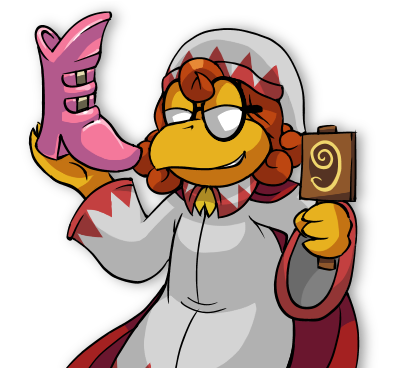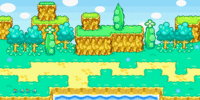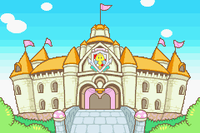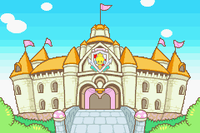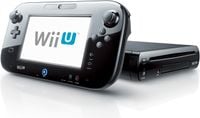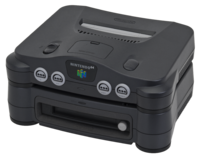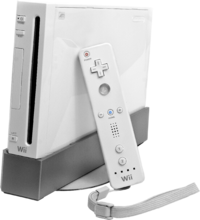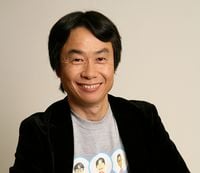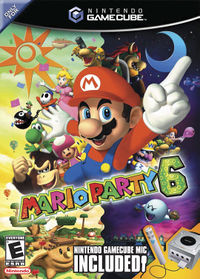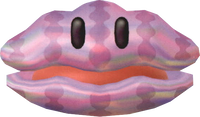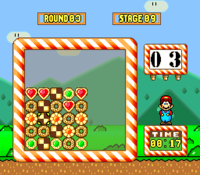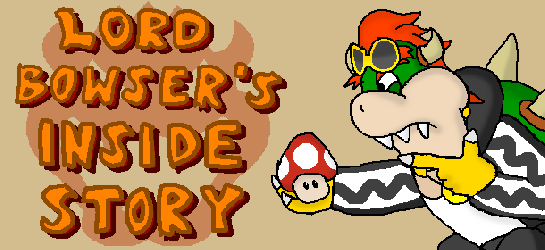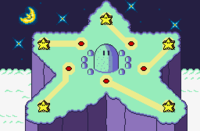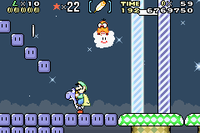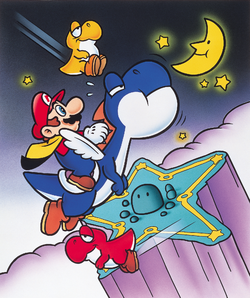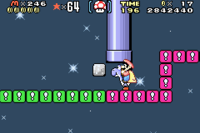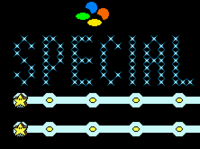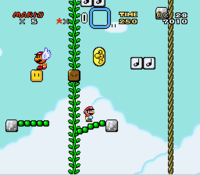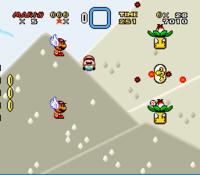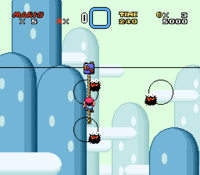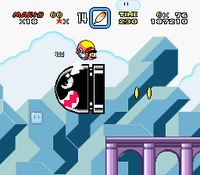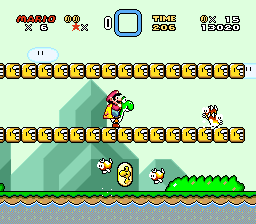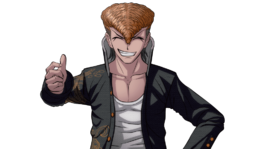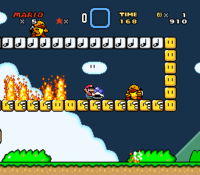The 'Shroom:Issue 125/Critic Corner
Director's Notes
Well, the Awards sure happened! This summer flew by because of it but now that it's over this last week has felt like an eternity, likely because my vacation is coming up and time manifested itself as a spiteful entity bent on making my suffering worse.
I fully intended this month to be a slow one with the Awards Ceremony being just last week, but we still have quite a packed page! We also have several bits of exciting news! Lord Bowser (talk) is our new Fun Stuff Director, and I'm hoping the best for him, as I know what it's like suddenly having these new responsibilities--just been over a year for me as CC Director. But with the new job does come some perks, those being having a hand in how this humble little Mario magazine comes together, its policies, who writes for it, the direction it takes, and whatever other fun new things you can think of bringing or helping with, so good luck and have fun! We also new banners for Critic Corner, Fun Stuff, and Fake News, as well as for the Main Page, provided by myself as part of the annual Awards Ceremony and conveniently also to replace some designs that needed some updating! I'm extra proud of these so please be sure to check them out :)
Next month we will be accepting feedback, comments, and reflections of this year's Awards Ceremony and everything about it, so if you've got something to say please send me a PM on the forum and I'll be sure to post it or pass it along. By the time next month's issue is posted, I'll be packing up for my vacation, so, I can't wait, but I have to anyways because time is real in this dimension, so while we wait for that to pass please enjoy some lovely reviews~
Section of the Month
| Critic Corner SECTION OF THE MONTH | ||||
|---|---|---|---|---|
| Place | Section | Votes | % | Writer |
| 1st | Anton's Half-Baked Reviews | 11 | 44.00% | Hypnotoad (talk) |
| 2nd | Meta Knight's Boss Battle Reviews | 4 | 16.00% | Meta Knight (talk) |
| 3rd | Shoey's Shoetacular Reviews | 3 | 12.00% | Marshal Dan Troop (talk) |
df i swear to poochy if you don't share any cookies i'm gonna _
[read more]
"My name is Yoshi876, you clicked this page, prepare to uhhh read reviews I guess!"
[read more]
This week The Sun is in Leo, Mercury is in Virgo, and Lord Bowser is in Super Mario World
[read more]
Could Have Been
Hello everyone! My name is Alex95 and welcome to "Could Have Been". In this segment, I talk about features that didn't quite make it into a game's final release and see just how the cut content would've affected the game. With the upcoming release of Mario & Luigi: Superstar Saga + Bowser's Minions on our minds, I thought it only makes sense to cover what went into making the original game. So let's dive right in and take a look at what could have been.
First of all, let's address the biggest mystery here: cameos. In the final game, whenever you create a new blend at the Starbeans Cafe, Professor E. Gadd will show up, taste the blend, and reward you with an item. Well, did you know that E. Gadd was only supposed to show up for the first blend? But then, who was supposed to fill the remaining spots? Why, other Nintendo characters, of course! Hidden in the game's coding are fully functional sprites and dialogue for Wario, Fox McCloud, Captain Olimar, Samus Aran, an Excitebiker, and Link, who were set to appear in that order. …Well, almost fully functional, anyway. Wario through Samus are fully finished, however, the Excitebiker reuses his 8-bit NES sprite and Link has a Japanese character grouped with him (I believe it reads "test"?). Olimar also speaks in the text boxes that show when you collect an item in the game, and he also tries to attack Luigi. Like how E. Gadd does so in the final game, these characters were supposed to give the player items. E. Gadd still gave out a Game Boy Horror (though a standard one, not the Game Boy Horror SP in the final), Wario was to give a "Wario's Gold" (Greed Wallet), Fox gives a "Gold Ring" (Bonus Ring), Olimar gives a "UV Lamp" (Cobalt Necktie), Samus gives an "Energy Tank" (Power Grip), Excitebiker gives the Excite Spring (unchanged), and Link gives none other than the "Triforce" (Great Force). With these characters nearly completed, why then did they go unused? Just a guess, but it may have to do with the game's developer, Alphadream. It's possible they were only given the rights to use Mario and the others, and not the special guests. It is likely Alphadream made the characters and implemented them partway, but once they were brought to the attention of Nintendo, it was rejected. Sad.
Next are some unused items. The coding in the game lists unused gear, along with their corresponding in-game text.
- Chuckola Pants - Pants made to look like Chuckola Fruit.
- Heavy Slacks - Very heavy pants made of Hoohoo Blocks.
- Light Slacks - Very light and made of Parabeanie wings.
- Jeanie Jeans - Magic jeans that boost DEF in battle.
- Jeaniest Jeans - The best-looking, best-fitting jeans.
- Safe Guard - An outfit that blocks status ailments.
- Oho Gear - Pants with a raging wave print.
The Oho Gear is actually obtainable in the Japanese release of the game, but not in the other regions through legitimate means. The Bean Fruit also came in an assortment of colors, perhaps signifying which Yoshi to give them to, but only the purple one made it into the final game and it can be given to any Yoshi to make things easier. There are also unused yellow, red, and blue coin sprites, with flashing animations that signify when they're about to disappear. With that information, it's possible they were dropped by something, possibly enemies, and their value could correspond to their values in Super Mario 64, if we're just going off of color. What appears to be an earlier version of Lady Lima is also hidden in the game's coding, but perhaps the most interesting unused character is an enigmatic cloaked Beanish. Based on the pose, it looks like they are sitting on something, probably a ledge of some sort. Perhaps they would have observed the Bros. as they went on their adventure, but what the actual role of the character would have been is unknown. My guess is they would appear in places with puzzles, and Mario & Luigi have to pay them for advice.
There are also some unused enemies! Some of them are dummy Goomba enemies, though there other variants of the Goomba that appears: a blue "Mossy Goomba", a red "Pop Goomba", and a Paragoomba. You were also going to be able to fight (an overly happy-looking) Sergeant Starshade of the Starshade Bros., possibly in a tutorial for the Bros. Attacks. While they do appear in the tutorial battle, you don't battle either of them directly. You also battle a Hoohooligan for some reason. The game's code contains a few more enemies without graphics: "Chompa", likely a Mecha-Chomp, "Sharkbone", possibly the name of the undead version of ???? as evident by the Nintendo Power guide, and names for Hermie III's pincers.
Now what about areas? Were there any unused? Well, yes and no. There's an unused Toad in the beginning area that can't be interacted with, an fully functional Save Album in the Koopa Cruiser room with the barrels, and some test areas. But the really interesting bits are the battle arenas. Usually, you can only see the one square area of the battle, but every battle background is actually extended horizontally! Every single one of them! The only ones you can actually see use this mechanic is during the final battle or against Trunkle. The scrolling background was finally implemented in Mario & Luigi: Bowser's Inside Story during Bowser's battles, but perhaps some of the Bros. Attacks were supposed to make use of them.
Anything left? Yep: regional differences! Despite versions of the games being released at a maximum of eleven days apart, there are a surprisingly large number of differences between Japanese and non-Japanese releases. The title screen has a different logo and font, which is usual in Japanese versions of games, so that's not surprising. What is surprising (at least to me) is the changed detail on Peach's Castle. Outside of Japan, the motifs on Peach's Castle look like mushrooms kinda, but in Japan, the images resemble those lovable Mushrooms more closely, though more akin to the Golden Mushroom I guess. Also in Japan, during the beginning intermission where you control a Toad, an image of the ![]() shows telling you movement is possible, but the image is absent in other releases. Never fear, though, as the
shows telling you movement is possible, but the image is absent in other releases. Never fear, though, as the will show in its place in the remake! All these are exclusive to Japan: Bowser's sprites are touched up to show more detail, Heart Blocks appear in three locations, the Brothers start off with more BP, Lakitu shows how to control during the Level Up screen, an icon shows when you made a blend in Starbeans Cafe to better keep track which ones you've already made, enemy stats are different, and most importantly, a barrel had its location changed in an area of Chucklehuck Woods! Clearly Japan got the better end of this deal!
Well, I hope you enjoyed this look into Mario & Luigi: Superstar Saga, and I also hope you're looking forward to the remake, because it's looking good so far! If you wish to see for yourself the stuff left out of this game, I recommend going to our page here or by checking out the pages on The Cutting Room Floor! Which game do you want me to cover next? Until next time, see you around!
Welcome to Part 2 of my 3-part fizzy things review spectacular extravaganza “pop ‘til you drop” carbonated bubble fest Sponsored by Tips People Give Me For Being Really Good At Giving Them Pizza spectacular. This month I’m trying not to lose my mind with being overwhelmed with a bunch of stuff for the Awards Ceremony that is technically already over by the time you’re reading this, as well as my actual job, plus side jobs like shooting weddings, and also ‘Shroom stuff like this but not Dear Anton which Gabumon (talk) graciously took over and Superchao (talk) offered to. In the spirit of wellness, I’ve selected vaguely intentionally-healthy fizzy drink options to try.
Gerolsteiner sparkling mineral water
This seemed like the most basic so I started with this. Gerolsteiner is a German export that’s apparently been around since forever, but I asked Gabumon (talk) about it and he had no clue, only telling me that Germany really likes their 1000s of drink selections. I bought these ones specifically because they were $1 each and looked nicer than the other bottles. According to their website, this water comes straight from some big hole in the ground somewhere in Germany called the Volcanic Eifel, which lends to it the various minerals that allow this company to call it ‘mineral water’. It also says that the water is naturally carbonated which is like...surprising?? I totally didn’t expect that at all, but apparently that’s a thing that can happen. The website also has some stock photo white lady telling us that the main minerals are calcium, magnesium, and bicarbonate, which I’m sure will alter the taste slightly as do all kinds of other natural water products with various minerals in them for hype and aesthetic.
I tried it straight first. I had to clench the side of the counter and use up half of my mana to not immediately start retching. I’m not sure what it was but it just tasted like it shouldn’t exist. Maybe it’s because I’m someone who drinks A LOT of soda, mostly Dr. Pepper, because at work we have it on tap and I hydrate with that, and the idea of all of the bubbly but none of the flavor just felt wrong. I have to keep an eye (tongue, rather) on the flavor of the fountain beverages because something tasting off could mean the syrup is running low or the CO2 tank is almost empty, and this sparkling mineral water tasted like that.
Kids don’t try this at home, I am a trained and licensed adult. I mixed the sparkling mineral water with orange juice, Mucho Mango AriZona, and vodka. Did you know AriZona is actually stylized like that?? I just found that out right now when I Googled what the mango flavor was called and I previously thought it was just the font or something and just “Arizona”. I tried this because it’s what I usually do when I mix drinks: mix vodka, Sprite, and a fruity juice like orange, passion fruit, or pomegranate. Each of those separately were kinda _____, leaning towards bad; mixed together and they’re pretty much a classic drink so like of course it tasted alright. I also mixed it with pomegranate cran-grape something something bitter old people juice. The sparkling water immediately turned it into a portal that brought me back to New Year’s Eves when I was ages 10-20 and could only drink sparkling wines and not real alcoholic drinks. It was very good, and a lot cheaper than what it reminded me of.
Rating:  Regular corn chex piece
Regular corn chex piece
Explanation: Sparkling mineral water seems to have its use for me mostly in just being mixed into other drinks to add carbonation and dilute stronger flavors. Some people will like it just as it is, for whatever reason they may have, and while entirely valid, I need it to function as a vehicle for some more flavor.
Coco Libre Organic Sparkling Coconut Water
I wasn’t expecting much too different between this and the regular sparkling water, beyond the Gerolsteiner tasting “cleaner” because it doesn’t have coconut nonsense in it. I got 3 flavors because I couldn’t decide and also they were only $1 each: Original, Grapefruit, and Cucumber + Lemongrass. I couldn’t really find much useful information about what this is or anything so I guess it’s just like literally organic coconut water with some carbonation.
Starting with the Original, I sniffed it because I guess I figured I just should, like wine tasting. I should totally start a GoFundMe to go on a winery tour and review local wines and get drunk while doing it, there’s plenty of wineries here and I never see any reviews in the papers or anywhere. Anyways it smells like wet sock water, which braced me for it tasting just like that, too. It didn’t send my body into convulsions immediately like the Gerolsteiner sparkling mineral water, which gave me the false delusion that it would be alright, until 4 seconds later when it suddenly felt like my body was ejecting my entire digestive tract. As I did with the sparkling mineral water, and because the Coco Libre website said that mixing it into cocktails was like one of three purposes this thing even has for existing, I mixed it with orange juice and pomegranate something whatever juice achieving similar results.
The Cucumber + Lemongrass was pretty alright, I wasn’t immediately disgusted by it. The smell and flavor are pretty accurate to what it’s called, and I’m sure this would be a good flavor if it wasn’t carbonated because it’s really mild and would be better smooth. Everything I mixed it with tasted bleh and unremarkable, so I pretty much forgot what they were like to come and describe it to you, the reader, in more detail.
Grapefruit made me feel some kind of reaction, similar to what sucking on a lemon would do to people who don’t like lemons, but I don’t exactly know what that’s like because I am one of those people who will just eat a lemon. It mixed really well with orange juice, probably because it was a similar citrus flavor, but was only good for like a quick flavor shot. When mixed with pomegranate juice I could chug like 7 gallons of it.
Rating: 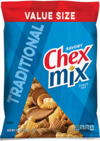 Traditional Savory Chex Mix
Traditional Savory Chex Mix
Explanation: It’s literally the same thing as Traditional, just with a little bit of a marketing gimmick. I’m sure you can placebo effect your way into believing that it’s better in some way, which it’s possible that they’ve tweaked the recipe some, but not in any really meaningful way. It still has the same pros and cons as the original, just with the added you feeling better about yourself.
KeVita Master Brew Kombucha
I saw this while I was contemplating using my Pom Wonderful coupon that I always cut out but have literally never purchased that drink before, read that it was carbonated, and was like “WOW I CAN TOTALLY USE THIS TO FILL MY SHROOM SECTION”, and then snagged a couple quickly before I could regret the decision. I did research on what this was after I tried it, which was probably a mistake. The website has this huge banner of some white dude doing yoga in a bunch of mud or wet sand or something, which is an immediately red flag that this is a garbage product that’s overpriced just to appeal to well-to-do people who believe that just because they haven’t had a cold in 2 years that vaccines are no longer necessary. It’s a sparkling probiotic drink; kombucha being tea fermented with bacteria and yeast. Quoting from the Wikipedia page for Kombucha, “Kombucha has been promoted with claims that it can treat a wide variety of human illnesses, including AIDS, cancer, cardiovascular diseases, and diabetes, and that it provides other unproven beneficial effects such as stimulation of the immune system, boosting the libido, and reversal of gray hair.” I’ve also had a guy at work who drinks this stuff say it’s good for staying ‘regular’. Wikipedia also literally says “There’s no peer-reviewed studies that proves that this is healthy at all or even does anything (...) Although it has been claimed to have numerous health benefits, there is no good evidence that drinking kombucha has such effects. By contrast, there are several documented cases of serious adverse effects, including fatalities, related to kombucha drinking, possibly arising from contamination during home preparation. Since the mostly unclear benefits of kombucha drinking do not outweigh the known risks, it is not recommended for therapeutic use.” As you can see, the dedication I have to writing this section is the most dedicateliest out of everyone so please give me awards and monetary gifts.
Now, back to the past when I actually tried this drink. Reading the bottle, it says: hand crafted, gluten free, non-dairy, vegan, live fermented Kombucha culture, non-GMO, non-alcoholic, certified organic. It hits all of the buzzwords. The bottle also says nontaxable and it’s a food product but the grocery store still taxed it, so I’m UPSET. There were a lot of wild wacky hipster flavors, but I figured I’d spare myself and get the recognizable ones like raspberry lemon and tart cherry.
First up was the raspberry lemon. It kinda smells like when you take off a wet bandage and reapply peroxide to it. I can’t taste the raspberry at all but the lemon is certainly there and boy does it make it taste worse. It kinda tastes more like the ginger cola than anything, but without the sugar. The trick to drinking this without choking is take a deep breath before a sip and hold it, exerting all of your energy into not smelling it. I can totally see why this is marketed to delude people into believing it’s good for you. I spent $5.50 for two of these, on sale, so I’m determined to chug them even if it kills me.
The tart cherry one didn’t smell as bad as the raspberry lemon so I didn’t expect it to be too bad. Joke’s on me, it was far worse. It was so tart that my face puckered hard enough to cave in on itself, creating a small black hole, killing me. I died and am now dead. I’m not too sure that’s exactly the goal of a probiotic. If I had to explain the smell, it’s like the smell you get after you stomp around in grimy pond water in socks, then continue wearing those socks while working in a hot kitchen for 10 hours until your feet rot and are replaced by the gunk similar to a fossilized tree stump, and then finally trying to air your feet out and in an effort to prevent the stench from destroying a nearby city you spritz a little store brand lemon air freshener on them and call it a day. That’s it, that’s the smell, and the tart cherry kombucha is apparently made from my old socks, harvested from the garbage, soaked in water to age, then wrung out into glass bottles for resale.
Rating: I don’t feel comfortable even putting Chex Mix on the same scale, it doesn’t deserve this
Explanation: These are on a completely different plane of existence than anything Chex Mix has created. Sure, Chex Mix does try to play itself off as being a better healthier choice than potato chips, which is technically true and they stay in their lane about it. These KeVita drinks not only are a fraud, they are an expensive waste of money and are the worst taste I’ve ever experienced in my life.
P.S. Sorry there's no image this month. I wanted to do one but had absolutely no time to do it, so if you really wanted to see one either imagine it or do it yourself: my idea was some smelly foot-themed drink sponsored by Nabber with the slogan being some Tarantino pun.
Tune in next month where I review more fizzy things! Also, tell me what to review next! Here’s my Steam Inventory filled with games I haven’t played for some ideas, but things you can tell me to do can also be movies, shows, physical actions, trying new foods, music, literally anything and I’ll cover it eventually if it’s not too ridiculous. Just send me a message here on my talk page or PM it to me on the forum. Don't like what I have to say? That's fine, and probably bound to happen because I've been told about how much people like Super Mario 64 and how they feel about any criticism of it! We at Critic Corner will welcome your alternate review of it as a new section for the next issue!
Countdowns
Written by: Luigi 64DD (talk)
Hello, fellow wikians! I'm Luigi 64DD, and I'm here to deliver straight to your computer (or phone) another Countdown of magnanimous magnificence! Before we be begin, thanks for voting my section for Issue 123 into 2nd in Critic Corner Section of the Month! Now I just have to figure out how to overthrow Ant-- I mean, long live our glorious Hypno-Director! Phew, that was close. Anyway, this month's countdown is actually two countdowns: the Top 5 Biggest Nintendo Mistakes and the Top 5 Nintendo Successes. First, we'll be looking at the decisions that hurt Nintendo in sales and overall success, and then we'll be looking at the decisions that did precisely the opposite. This means that decisions that fans hate but that don't hurt Nintendo (like taking down fangames) and decisions that were bad but didn't hurt Nintendo in the long run (like the 3DS's launch) will not be included. That being said, get your magnifying glass, and let's examine Nintendo's history!Mistakes:
5. Product Shortages
We start off our list with a decision that has received a lot of criticism from fans. Within the last 10 or 11 years, there have been several Nintendo products that have been severely under-produced. For many months after the Wii was released, it was very difficult to find the console because Nintendo's supply did not match the overwhelming demand, making most stores sell out very quickly. The same situation is happening now with the Nintendo Switch, undoubtedly to many of our users' chagrin. Similar problems with the amiibo supply have cased much controversy and are still causing some amiibo to be very rare to this day. In the cases of the Wii, Switch, and especially amiibo, Nintendo was using a business strategy of playing it safe by under-producing the products, which is meant to raise demand even further. Even so, I can't help but wonder if they would sell more overall if they didn't use this strategy. In any case, under-producing these products did not hurt Nintendo very much. However, what I believe did hurt Nintendo was under-producing a more minor console: the NES Classic Edition. While this console's case was very similar to the others at first, what made it worse than those was that they cancelled production of the console when the demand was still quite high. Granted, they didn't expect it to be as popular as it was, but they really should have taken advantage of it while they could. Unfortunately, the upcoming SNES Classic Edition is likely to follow in the footsteps of its short-lived cousin, but we can hope that Nintendo will wise up to the fact that they'd do better to produce more units.
4. Virtual Boy
One of the things that make Nintendo consoles great is that they often try to do something unique, new, and revolutionary. Usually this works out quite well, garnering massive sales and sometimes producing imitators. But sometimes, even though the console is doing something revolutionary, it doesn't work out so well. The prime example of this is the Virtual Boy. In the early nineties, Nintendo gained the license to use 3D stereoscopic head-tracking technology made by Reflection Technology, Inc. to make a game console. They then experimented with the technology to make it affordable and health-conscious. Seeing that the head-tracking feature caused motion sickness and risk of lazy eye, they removed it and focused on the stereoscopic 3D feature. Even then, the system caused symptoms such as dizziness, nausea, and headaches. After several years of development, Nintendo began pushing for the Virtual Boy's release so it could focus development on the Nintendo 64. However, the console was unfinished and it had been severely downscaled from the original idea. Despite this, the Virtual Boy was released in 1995. It was a commercial failure and was panned by critics. Its failure was attributed to its high price, health problems, and poorly handled marketing. So, I think what went wrong with the Virtual Boy can be described in two words: too early. In the most basic sense, it was too early because it was rushed to market in an unfinished state to focus on the N64. However, on a wider scale, it was too early because the technology just was not advanced enough to do the revolutionary thing they wanted to do: stereoscopic 3D. It would be over 15 years before they succeeded in implementing 3D properly with the 3DS. So the moral of the story is: be revolutionary and ahead of your time, but not so far ahead of your time that you can't even do it properly.
3. Wii U
I've been having a lot of fun with my Switch lately. When I'm not playing in handheld mode, it sits in its dock atop my Wii U, a rather symbolic placement for a console triumphant over the console defeated. Speaking of which, why was the Wii U defeated? What caused it to fail? Well, there were many reasons for the Wii U's failure. First of all, it was not marketed well at all. When it was first revealed, no one could tell whether it was a new console or just a tablet peripheral for the Wii. This was due to the trailer's vast focus on the gamepad without showing the console itself, and the fact that used the Wii's name, just with an extra U. Furthermore, the trailers primarily showed children playing it, turning off older consumers. Another reason is that it was difficult to develop for because of the abnormal gameplay style of having two screens, causing third-party developers to shun the console. This and Nintendo's failure to consistently release first-party titles led to a huge lack of games. But what was perhaps the biggest problem was that it tried to ride on the success of the Wii and didn't establish itself as its own entity. It even used Wii Remotes as seemingly the primary multiplayer control option! What they should have done is taken the console's concept farther and drop its connection to the Wii besides simple backwards compatibility. Perhaps we could have seen a system like the Switch, taking the console Off-TV play farther. Or perhaps it could have kept the two-screen feature while truly communicating the revolutionary concept that they were trying to realize.
2. N64DD and N64's Specs
For two console generations, Nintendo had reigned supreme in the console market. There was no one of any real clout to challenge them in the NES era, and while they had competition from the Sega Genesis for the SNES, they managed to edge that console out before Sega began to obliterate itself by releasing way too much hardware. In the next console generation, however, Sony's Playstation decimated Nintendo's dominance, selling over three times as much as the N64. Why did this happen? If they formerly had had dominance in the market, shouldn't they have at least done a little better than they did against Sony? The reason for what happened is not just that the Playstation was great; it was that the N64 was lacking. The N64 used cartridges, which had far less storage capacity compared to the Playstation's CD-ROMs. Nintendo opted for cartridges because they did have some advantages over CD-ROMSs, but the inferior amount of storage made a lot of third-party developers move to the Playstation, including Square, which had always put the Final Fantasy series on Nintendo's consoles until--you guessed it--Final Fantasy VII, the most famous game in the series. To remedy this, Nintendo developed the 64DD, which had a magnetic disk drive for more storage that could also be written to, allowing user-created content to be saved to the disk. However, the 64DD went through several years of delay until it was finally released in Japan in 1999 to commercial failure, never being released anywhere else. All of this could have been averted if they had either replaced cartridges with CDs to begin with or had the N64 and 64DD be one system from the start. As it was, the N64 was unable to compete properly with the Playstation, ending Nintendo's reign which they would not get back for ten years.
1. Sony Partnership Failure
The last two entries on this list were mistakes that caused Nintendo to lose a console generation. That's pretty bad. But you know what's worse? Indirectly creating the competitor that beat them in those console generations. In 1988, Nintendo and Sony made a deal in which Sony would develop a CD-ROM peripheral for the SNES. Later on, they decided to also produce a standalone console featuring ports for both SNES cartridges and CDs called the Play Station (two words). Everything seemed to going fine, until Nintendo took a closer look at the contract. They saw that the way the contract was worded gave Sony full control over the CD-based games made for the system, giving a majority of software licensing control for the system. In retaliation, Nintendo began negotiations with Phillips to produce the SNES CD add-on with them instead (which never happened, while it did lead to some of the worst Mario and Zelda games in existence), all without Sony's knowledge. Therefore, at the 1991 Consumer Electronics Show, Sony revealed the Play Station, after which Nintendo suddenly revealed their partnership with Phillips. This shocked and angered Sony. After this, they attempted to create a deal where Sony created the hardware with Nintendo having licensing rights for the games, but it was too late. The few prototypes produced were never released, and Sony went on to try to negotiate with Sega before finally making a console by themselves: the PlayStation (this time only one word). The PlayStation was a huge success, and as was discussed in the last entry, took dominance of the gaming market from Nintendo. So, Sony was being unfair, but Nintendo should not have backstabbed them like that. It ended up making Sony angry, so much so that they not only quit the deal with Nintendo, but also tried to make a deal with Sega, Nintendo's biggest rival. If Nintendo had reworked the contract without offending Sony, perhaps Nintendo would've never lost control of the industry, because Sony would not be their rival and they would co-own a system that played CDs, essentially making number two and possibly even three never happen. Of course, this is all seen from hindsight, but just imagine what could have been prevented had they come to a more peaceful agreement.
Successes:
5. Winning the 16-Bit Wars
So the first entry on our successes list is only partly Nintendo's doing. While what Nintendo did helped them ultimately win the 16-bit wars, Sega's mistakes also contributed to it greatly. The Genesis was released in 1989, but did not become a huge success until a few months before the SNES's launch, when they lowered the price, expanded advertising, and perhaps most importantly, introduced Sonic the Hedgehog as a pack-in. Many people who had been waiting for the SNES's release decided to buy a Genesis instead. So the Genesis continued to outsell the SNES until 1994. In that year, Nintendo released Donkey Kong Country, which became very successful and boosted the SNES's sales. Furthermore, Sega released a add-on for the Genesis called the 32X. This was the second add-on released for the Genesis, after the Sega CD released in 1992 which didn't sell that well. The 32X, however, was a commercial failure. Sega never achieved dominance after that, as they began focusing on the Saturn, which also became a failure. So, even though Nintendo didn't cause it so much as Sega did, it was still good that they managed to gain the edge over Sega before they completely lost it to Sony in the next generation.
4. Wii and DS
In the years after the release of the Gamecube and Game Boy Advance, Nintendo needed a way to to get back in the game. The GBA had sold well, but the Gamecube had followed in the steps of the N64 in many ways and had consequently fallen behind both the PlayStation 2 and the Xbox in sales to become Nintendo's worst-selling main home console. Furthermore, Sony's upcoming PlayStation Portable was a handheld powerhouse that was wooing the gaming market right and left. The general expectation was that Nintendo was going to be beaten in both the home console and the handheld market by the other companies. However, Nintendo had a plan. They understood that they had no chance at combating their competition with raw power. Instead, they chose to provide new, revolutionary play experiences as they had always striven for. So, Nintendo started the Revolution. First, they unveiled the DS in 2004. At first glance, this system didn't seem like it could beat the PSP to the gaming market. But the amazing new ideas created by having two screens, one normal and a one touch screen, captivated gamers around the globe. The DS went on to not only beat the PSP in sales, but to also become the best-selling handheld game system of all time. Next, they revealed the Wii in 2005, to be released in 2006. Again, this did not immediately look like it could beat the other consoles, sometimes being accused of being childish. But the motion controls of this system had never been seen before, and this combined with the console's relatively low price and pack-in game gave it massive popularity, especially among families. The Wii not only became the best-selling home console of its generation, it also became the third best-selling home console of all time and the fifth best-selling game system overall. It also produced imitators by the other game companies, such as the PlayStation Move and the Xbox Kinect. Nintendo's focus on providing fun new experiences in this generation was a great idea, providing fun experiences for players and definitively winning the console generation.
3. Game Boy
In the height of the NES's popularity, Nintendo decided to start developing another type of game console: a handheld. They had already done some experimenting with handheld with the Game & Watch, but this was the first time they tried to make a full-fledged handheld game console. At that time, there had been few handhelds released, and the ones that had were failures. As the Game Boy was being developed, the reception of the console within Nintendo was not good, with Nintendo employees making fun of the codename (which was Dot Matrix Game, by the way). Nevertheless, the console was released in 1989. Instead of bundling the system with the obvious choice of Super Mario Land, Nintendo opted to bundle it with a puzzle game from Russia called Tetris. This decision was a great idea, as it boosted both the Game Boy and Tetris to huge popularity, although other factors such as the system's cheap price and long battery life certainly did not hurt. The Game Boy is extremely important to Nintendo's history, for it not only created the handheld gaming market, but also established a lifeline for Nintendo to fall back on whenever a home console failed. What I mean by this is that since Nintendo has always dominated the handheld market, it lessens the blow of consoles such as the Gamecube and Wii U performing poorly. And the amazing thing is that, excluding revisions like the Game Boy Micro, every one of Nintendo's handhelds have been a success. This is why the Game Boy is forever a great decision on Nintendo's part.
2. NES
Now here's a big one. After Nintendo had released the Famicom in Japan to moderate success, they began determining a way to bring it the American market. Their first attempt in 1983 was to have Atari market the console, as Atari was the leading name in gaming at that time. Atari and Nintendo were about to sign the contract when it was made known to Atari saw that Nintendo's game, Donkey Kong, was being demonstrated on their competitor Coleco's Adam computer when Atari was supposed to have exclusive computer license for the game. Atari refused to sign, not realizing that the game was only playing on Coleco's computer because the computer had backwards compatibility with a console made by Coleco, which Atari did not have full license for. By the time the issue was cleared up, Atari was having financial problems as a result of the videogame crash of 1983 and was unable to sign the contract as a result. So without Atari to back them up, Nintendo decided to turn their system into a home computer akin to the Commodore 64 called the Nintendo Advanced Video System in order to avoid the stigma against videogames caused by the crash. Despite this attempt, the public was not impressed when it was revealed in 1984, still citing the fact that the videogame market had disappeared. So, in 1985, Nintendo revealed the Nintendo Entertainment System, a console much closer to the Famicom designed so as to not look like a console. Furthermore, they avoided terms associated with gaming, packaged it with ROB to give the impression of a toy rather than a videogame, and embarked on a intense marketing campaign to convince retailers to sell the system. This brilliant strategy, combined with amazing games such as Super Mario Bros., led to massive popularity and revived the game industry as the public was reminded that games put through quality control can be great, unlike the crappy cash-grabs that caused the Atari 2600's demise. Gaming today would not have existed if it were not for the NES. It also may not have existed without Super Mario Bros., which leads us to the final entry on this list.
1. Hiring Shigeru Miyamoto
Well, that's it, folks! Agree? Disagree? Want to bash me over the head whilst saying Paper Mario: Sticker Star was Nintendo's worst decision? Whatever the case may be, please share your thoughts in my Countdowns discussion thread and read whatever bonus content I decide to put there. Well, I hope you enjoyed this list, and don't forget to come back for another fabulous edition of Countdowns! Until then, Auf Wiedersehen!
Marioverse Reviews
Written by: Rosalina1999 (talk)
Aloha! It's August now and Summer Vacation is over. But we still are in the season, though. I'm sorry that I missed last month. I had no time whatsoever to write an article. But luckily I'm back for another great review this month! I'm going to review Mario Party 6!
Mario Party 6 released on December 6, 2004 on the GameCube. It was third overall Mario Party game on the GameCube. I am going to review the positives first and the negatives last. Let's go!
I love Mario Party 6 because it felt original. It has the Mario Party style everyone misses. Also, I like the idea of having a day and night mode. It doesn't make total sense to me to this day, but the idea is pretty cool, like the fact that Brighton and Twila have different rules and opinions. I guess the point is to try to get them to forgive each other and become friends again after you get so many stars, so that's different, in a good way. My favorite board is Castaway Bay, because it has a nice environment and there are two yachts. If you get to Bowser's yacht, you get a Shadow Star that takes away a star, or 20 coins if they don't have a star. If you get on Donkey Kong's yacht, he will give you a star for 20 coins, and take you back to the start instead of shooting you there from a cannon. Anyway, that's why I like the game pretty much.
There's not really anything I hated about Mario Party 6. It's the only Mario Party game I played on the GameCube, so it's perfect for me!
I will give Mario Party 6 a 10/10! It's really good, it has a great gameplay, and it's originality makes it feel like a real Mario Party, instead of the, ahem… Mario Party 9 game.
I hope you enjoyed this issue of The ‘Shroom, and have a nice day :)!
Character Review
Clampy
I thought long and hard about how to start this review, especially since I knew that you'd all be clamouring to read this. I didn't want to become clamplacent with my audience, and just throw terrible clam puns in as an introduction. But then I realised my only other introduction was praise for the Mario series for having such a wide and varied enemy pool, and that wouldn't work considering I'm reviewing a clam with eyes. So I figured that seeing as this section isn't well-known as being one of the more clamourous sections, the puns would go down a treat.
Clampy is, as you would expect, an enemy based off of a clam, and as such lies motionless. However, that is not to say that they aren't dangerous, as a Clampy will often have treasures hidden inside it to lure players in, before clamping shut on them. However, given the time it usually takes to close itself, the danger doesn't really manifest.
Which is quite a shame, because there's nothing else that can really be done with Clampy. Giving the enemy legs doesn't make sense, considering how clams don't walk naturally, but perhaps having it close faster would throw in a better risk versus reward mechanic. Failing that, it could copy Mario Party 10, and have it spit a bubble stream which would also damage the player. Either scenario works well for me, and would improve a relatively easy enemy.
The only other appearance that Clampy would make is in Mario Kart 7, where it copied what it does in the main series, by having coins, and closing on racers. It works really well here, especially since the risk versus reward mechanic is a whole lot worse. In the main series, the risk was only there is time was low, or if you only had one hit left, here, if you're trapped in a Clampy, you feel it. Especially on the higher CCs. My only issue with Clampy in the Mario Kart series is that it could have worked in Dolphin Shoals just as well, and I feel it was a missed opportunity to not have it there.
I like Clampy, it might be an easy enemy, and more imagination was put into the puns at the top of this section, but it does what it says on the tin. It contains a treasure, and snaps at you if you go for. Do you go for the treasure? Of course you do, it's incredibly easy to get. But, still, this doesn't detract from an enemy that really does suit the series, and I wish would appear more often, especially since underwater is a mandatory world theme in the series.
DragonFreak's Review Quest
Written by: DragonFreak (talk)
| Yoshi's Cookie | |
|---|---|
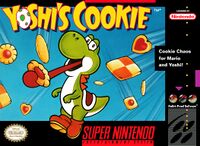
| |
| Developer | Bullet Proof Software |
| Publisher | Nintendo |
| Platform(s) | NES, SNES, Gameboy, Virtual Console |
| Genres | Puzzle |
| Rating(s) | E |
| Available From | |
Hello everybody! It's been a week since the Award Ceremony, which was amazing. I hope you go to the Forum and read everyone's presentations because everyone did a wonderful job! Also I've been so busy with presentations that I wasn't sure if I would have time or the energy to make this section...but you're reading it right now so it looks like I did. I also planned to review a game that was listed as a nominee for one of the Awards, and out of all of them, I have decided to review Yoshi's Cookie.
Yoshi's Cookie was released for the NES and the SNES in 1993 for North America. Yes both versions were released in the same year, which is sort of weird, but maybe they did it for accessibility sake. I played the SNES version, so the review will be based on that. Looking at a little bit of video, the NES version is largely the same exact thing. Yoshi's Cookie is a tile-matching puzzle game. To the play the game, you must matchup same-styled cookies in an entire row or column. You can shift rows left and right and columns up and down freely to make matches. Once matched, they will disappear and the rest of the cookies will combine together again. From the top and right, new cookies come in that will be added to your pile of cookies to match up. You win a stage when every cookie has been matched up. The only way you can lose is if you are slow enough so that either your stack of cookies reach all the way to the top or all the way to the right à la tetris. This is how you play Action mode, which is the main mode. It's pretty fun, but doesn't really get exciting until after the 3rd round or so on normal settings. It's also fairly easy as I managed to reach round 6 on my first attempt.
There's two other modes. One of them is a versus mode, which I did not try because I had no one to play it with. The other is a "puzzle mode" which is a curious title because the entire game is a puzzle. Anyway, in puzzle mode, you have to clear the board with a finite amount of moves. Now this is the mode I can really get into. It requires a lot more thought and strategy because every single move has to be more or less perfect. This may not be the mode for everyone, but it's the mode for me. I got up to round 3, stage 9 before giving up for now, so it's definitely harder that action mode.Yoshi's Cookie is a pretty fun game. It's simple, but it's effective on doing what it does. I would recommend for you to try it out if you are craving something like tetris, but not tetris itself. Who knows, maybe you'll get hungry for more cookies. I know I sure did.
Movie Reviews
The Princess Bride
| The Princess Bride | |
|---|---|
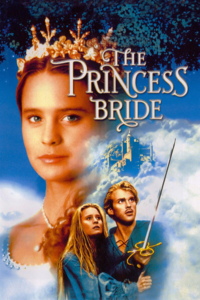
| |
| Genres | Romantic, fantasy, adventure, comedy |
| Release date | September 1987 |
| Starring | Cary Elwes, Robin Wright, Mandy Patinkin, André the Giant |
| Runtime | 98 minutes |
| Ratings | PG (UK) |
I find it a little bit strange watching things from before I was born. Watching a world that I never really knew. The Princess Bride was 10 years old when I was born, and yet despite this, it's a masterpiece that outclasses quite a few films that are being released at the moment *cough* Emoji Movie and Nut Job 2 *cough*.
The film follows the usual tale of true love between two people, Westley (Elwes) and Buttercup (Wright), and the challenges that they face to be together. Of course, in their case they might face more challenges than the average couple, seeing as Westley is captured by pirates, and presumed dead, leading to Buttercup becoming betrothed to an evil prince (Chris Sarandon).
There also a fair amount of sub-plots, including Buttercup being kidnapped by Vizinni (Shawn Wallace), and his two kind-hearted men, Inigo Montoya (Patinkin) and Fezzik (André); Montoya's quest for vengeance against Count Rugen (Christopher Guest); and the overarching one of the fact that the whole film is a book being narrated by a sick child's (Fred Savage) grandfather (Peter Falk).
And it's the last subplot I'm going to mention. The other two are reasonable enough, and entertaining to watch, especially the former, however, with the other one, while I respect the fact that it's necessary to set the events of the film out, the interruptions can grate. Occasionally, the kid questioning the grandfather over events can be cute, but for the most part you just want the film to continue.
One of the things that the film does really well is characters. Although a lot of them are one-dimension, Montoya is a prime example of this as his only character trait is wanting vengeance, they're still incredibly charming and captivating characters. However, Prince Humperdinck's motivations for war could be better explained, or explained at all. If he's a war-hungry person, then maybe the film should have done something to show that, instead of just having him plan to kill his bride, blame the neighbouring country, and invade them come out of the blue.
The other main thing this film does really well at is comedy. The film never takes itself seriously, and can be viewed as sort of parody of the swashbuckling fantasy films that came before it, and to be honest Westley's dead pirate costume does heavily resemble that of Zorro. Numerous little moments merit a chuckle, whether it's Montoya's questioning of Vizinni's overuse of the word 'inconceivable', or Miracle Max (Billy Crystal) ironically saying that Montoya and Fezzik will need a miracle after they leave him. Of course, the funniest scene, without a shadow of a doubt, is when Buttercup and Humperdinck are about to marry; it's set up as a serious scene, and the dramatic pause before The Impressive Clergyman (Peter Cook) speaks, and all seriousness just falls apart.
However, as the film was released in the 80s, one of the questions that will dog it is whether it stands up well today. Well, if you've read what I've said above, you should already have an answer to that question. And the answer is yes. Obviously, the set design hasn't really held up, but the characters, dialogue, and scenario could still work as a surprise hit in today's world.
Like I said at the start of this review, The Princess Bride is a masterpiece. The film ends with the kid asking his grandfather to come round again the next day and read the book to him again, and in all honesty, I wouldn't mind pulling up a chair and watching this film tomorrow again either.
Greetings, 'Shroom readers! This is Lord Bowser here with a new edition of Lord Bowser's Inside Story for you all! Again, apologies for my absence last issue, though don't worry, as I'm back in full force this month!
Today, I'll be covering a favorite game of many; Super Mario World. SMW has two optional worlds that serve as the game's extra content; Star World and Special Zone. Star World can be accessed via the various Star Roads found all over the game's regular worlds, while Special Zone can be accessed via a secret exit in Star World. The levels in both worlds are sometimes notorious, so let's get onto them!
Star World has a total of five levels. The world is unique in that every level has a secret exit in addition to its normal exit; in fact, the secret exits must be taken in order to advance through the world's levels, as the normal exits will not open up any additional paths. Some of them are tricky to get to, though for an extra challenge world, Star World isn't particularly cumbersome, thankfully. Star World is also where the rare and powerful colored Yoshis reside; every level has a different colored baby Yoshi that must be fed either five enemies or a power-up for it to grow; the full-grown Yoshi then has an extra ability whenever it has any color Koopa shell in its mouth. Red Yoshis spit out fire when the shell is spit out, yellow Yoshis cause small earthquakes when landing on the ground, and (the most game-breaking of them all) blue Yoshis gain the ability to fly. They're quite powerful, and well worth the effort to get them.
Star World 1 is an underground level, featuring a whole bunch of blocks that you'll need to spin jump through. The level also features a baby red Yoshi, along with many rare power-ups hidden amongst the blocks. The level is fairly straightforward; just spinning through all the blocks will eventually take you to the exit. However, in order to get to the secret exit, you'll have to stick to the right side of the level; you'll eventually land on a platform containing both a key and a keyhole. How convenient!
Star World 2 is an underwater level. Right off the bat, you're given a baby blue Yoshi and a conveniently placed Super Star, making for an instant overpowered blue Yoshi. The rest of the level features schools of Rip Van Fish, which can prove to be annoying if you're not a careful swimmer, though it's otherwise rather barren; there isn't much else to say about it. The secret exit is found underneath the pipe to the normal exit; you must swim underneath it to reach a hidden platform, again containing both a key and a keyhole.
Star World 3 is an athletic level, and a very small one too; it's only one short screen, with the goal only a few steps away from the starting point. There's a baby yellow Yoshi, a Lakitu to spice things up, and the entire level is made up of Grab Blocks, but even so... there really isn't much to say about this level at all, given how small it is. The secret exit is found at the top of the level; you must use Lakitu's cloud to float upwards to reach a ? Block containing a key, with a keyhole nearby.
Star World 4 is another athletic level, containing a lot of Koopas and Paratroopas. It's pretty straightforward as well, and not particularly gimmicky. To get to the secret exit, you'll need to have completed the Red and Green Switch Palaces, as a walkway to the key and keyhole is made up of Red and Green Blocks.
Man, a lot of the levels in this world feel rather... boring, quite honestly. Star World 1 was fun because "yay destruction lolz", but Star World 2 was just a flat underwater level, Star World 3 barely even counts as a level, and Star World 4 is just a generic athletic level. Despite the world's name, these levels are hardly the stars of the game. Sure, they have some unique Yoshis, and there's an entire other world past this, but this still remains probably the weakest world in the game based on level design. Even the secret exits feel rather lazy; while they're sometimes a bit hard to get to, the key is always right next to the keyhole instead of hidden somewhere within the level, which would've added more challenge and fun. I'll admit, I may be spoiled by the designs of levels in newer incarnations of the series, but I still do love some of SMW's ideas and originality. Star World just doesn't make the cut for me, and I feel like some of the world's potential was wasted. But oh well, I suppose even the best games may have their weak spots.
Moving on, Star World 5 is the tough level of Star World. The level starts off with a bunch of falling platforms, with a lot of Paratroopas among them. Past this is a section with blocks and more Paratroopas, making the first half of the level genuinely difficult to get through; as such, Cape Mario or a blue Yoshi is strongly recommended, and as they're necessary anyway for the secret exit, you'd be foolish not to have them. The secret exit is located above the level, on a walkway of colored blocks. Ideally, you'd need to have every Switch Palace activated in order to be able to access the secret exit, but you can cheese it with blue Yoshi or some good flying techniques. At the end of the walkway lies the key and keyhole, which will open up a path to the Special Zone.
And with that, we're out of the monotony of the Star World, and we'll go into the brutality of the Special Zone. Buckle up, buckaroos.
Special Zone is the last world in the game. It's known for its unique level names, all based off of stereotypical surfer slang; Gnarly, Tubular, Way Cool, Awesome, Groovy, Mondo, Outrageous, and Funky. All of them feature some sort of gimmick, and some of them are quite... notorious for that.
*LB glares at Tubular
*LB has war flashbacks
...Anyway, the Special Zone starts off with Gnarly. Unlike the entire rest of the game, this level is a mostly vertical level. You need to make your way up using ropes, vines, and trampolines, then freefall down again. There isn't really much stopping you, as there are no pits and the only obstacles are a few Paratroopas and enemies in the next part of the level. It's an innocent and fair enough level, and I don't have much against it, though I must admit; it's definitely not very aesthetically pleasing. Unfortunately, the innocence of the Special Zone comes to an abrupt stop at only the second level.
You've probably heard it all/experienced it for yourself, so I'll just make it brief. Tubular is quite literally hell on Earth... or Dinosaur Land in this case. Wait, is the Special Zone even part of Dinosaur Land? Where the hell is it? It's just a vast black expanse with some glittering stars and the Super Famicom logo, but there's nothing that tells us where we are... Are we in another world? Another dimension? Another game? Is that why the levels are weirdly named? Is that why we have monstrosities like Tubular, since this wasn't meant to be part of the original game? Who created this? Why were we sent here? Why does everything change color when we leave? Is that a parallel universe? Why can't we go back to the original colors??? What happened to the old Dinosaur Land?? Has it been... wiped out?????? Is that why we were sent here, to escape an impending catastrophe...??????????OH MY GOD THE SPECIAL ZONE IS EVIL HELP ITS THE DOWNFALL OF SUPER MARIO WORLD ITS THE FALLEN TIMELINE WHERE MARIO GETS LOST IN PURGATORY AND BOWSER WINS WHICH IS WHY NEO BOWSER CITY IS A COURSE IN MARIO KART ITS ALL CONNECTED WE DID THIS TO OURSELVES AAAAA A A A A A
...ahem.
Existential crisis over, there's a reason why Tubular consistently places high on our Worst 2D Level award; P-Balloons are a nightmare. Moving onto the next level, Way Cool's gimmick is a bunch of moving platforms on tracks. Their paths are controlled by the multiple ON/OFF Switches seen throughout the level, and Fuzzies and chainsaws run along the tracks as well. A bit difficult if you're not careful with jumps, but I do like the switch mechanic.
Next is Awesome, and let me tell you right now that the name is a flat-out lie; this level is the polar opposite of awesome. It's an icy level, full of holes for you to slip to your death.
yes i realize the pun in referring to an ice level as polar ive been spending too much time with icemario
...oh godDAMMIT there it is again help me please god
Anyway, Awesome is one of the harder levels in the Special Zone for sure. The slippery ground, the multitude of pits, and the loads of Banzai Bills and Paratroopas make it seem like you've done this level a great personal wrong, and it's out to get revenge in a horribly sadistic way. While it's definitely tough, it still pales in comparison to Tubular and other levels still to come.
Next is Groovy. The level should instantly appear familiar even though we've never played it till now; that's because it's the very same level that appears on the game's title screen. It's a fairly short and pretty simple level, serving as a nice breather from the harder levels in this world. Unfortunately, this sanctuary can only hold for so long... Let's take a moment of silence for the lives lost at the hands of the Special Zone.
...
...
Thank you. *sniff*
After Groovy comes Mondo Owada... I mean, just Mondo. Well, in a perfect world, it would be Mondo Owada, but this is hardly a perfect world.
Anyway, Mondo appears to be a normal overworld level at first glance, but its gimmick is water; it rises up and takes up the whole screen at its peak, then just as quickly falls back down. This repeats throughout the level, making for a rather aggravating trek. There are a lot of Cheep Cheeps bouncing around the level, which can be dangerous when they're able to swim. The level itself is basically a standard overworld level, but the rising water gimmick, while creative, can be a pain sometimes. It does spice up the level, and I like how it can change mechanics a lot, but the Cheep Cheeps are often hell to get by underwater. I just want Mondo Owada, not this... ;_;
The second-to-last level of the game, Outrageous, truly lives up to its name. By that, I mean it's outrageous that the developers made this level, and even more outrageous that they decided to keep it. There's Wigglers, Bullet Bills, Hammer Bros, and (for some godforsaken reason) Fire Snakes lurking among this forest of death. This is the second hardest level in the game in my opinion, only surpassed by Tubular. It's torture to get through, especially for one's first time; I died at least 20 times my first run through, and I still lose a fair amount of lives to this level today. Thankfully, the next and final level serves as a breather from this catastrophe.
The last level of the game, Funky, is... well... how do I put this...
...
...Fun.
Yes, it's fun. A final level in a Mario game is fun. This is truly a spectacle that must be rewarded!
I consider Funky to be fun because it uses a mechanic that I wish was used in other levels in the game; a low timer that can be helped with special berries that add on 20 seconds to the timer. The level itself isn't particularly challenging; in fact, it's rather tame compared to the rest of the Special Zone. The only potentially difficult part of the level is the low timer, but there are enough berries in the level to make this a moot point. The level ends with a message spelled out in coins -- "YOU ARE A SUPER PLAYER !!" -- and in the SNES version of the game, completing Funky transforms the rest of Dinosaur Land. The map palette changes from spring to fall, and various enemies receive (often strange) redesigns. While personally I prefer the original colors and enemies, it's a neat touch for finishing the Special Zone. Too bad the GBA version had the audacity to make achieving this a lot harder; instead of only completing the Special Zone, the player must also find all 96 exits in the game. That's just cruel!
And with that, we have covered Star World and Special Zone, the extra worlds of Super Mario World. Taking everything into account, they receive a score of...
6.5/10 (D)
As I've previously mentioned, a lot of Star World is quite dull, especially for extra optional content. Its levels felt mostly barren or generic, hardly my idea of fun. There was really a lot more they could've done in that world, but it, unfortunately, had been for the most part wasted. Special Zone was definitely more creative, but with levels like Tubular, Outrageous, and Awesome, it proved to be more painful than entertaining. I did like some of level designs and mechanics in this world, but all in all, it was a bit harsh for my liking. It's not on the level of bullshit as games like Super Mario Galaxy 2, but it's no walk in the park either. I still wish we got Mondo Owada instead of just Mondo... :(
And that's this month's edition of Lord Bowser's Inside Story. I hope you enjoyed this, and stay tuned for next month's review! Thanks for reading!
| The 'Shroom: Issue 125 | |
|---|---|
| Staff sections | Staff Notes • The 'Shroom Spotlight |
| Features | Fake News • Fun Stuff • Palette Swap • Pipe Plaza • Critic Corner • Strategy Wing |
| Specials | Awards 2017 Art Contest Results |

